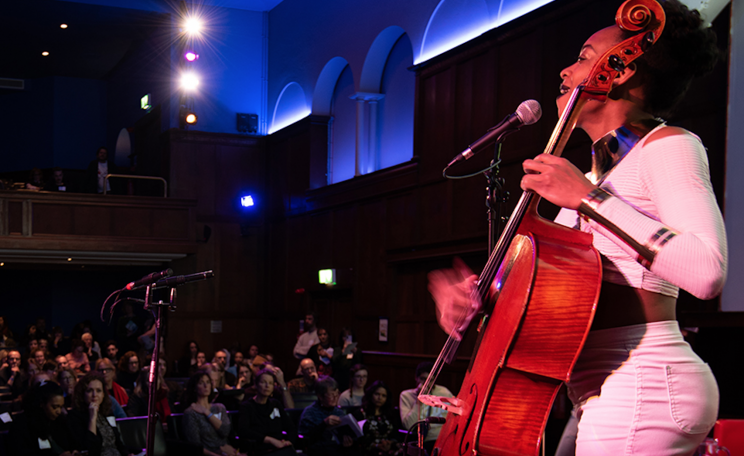This counter culture of the late 1960s began raising the profile of the environment, which was increasingly viewed as being under threat. Rachel Carson's book Silent Spring was published in 1962; Paul Commoner's Science and Survival was published in 1966
The revolutions broadly depicted in this brilliant new exhibition, Records and Rebels 1966-1970, from London's V&A Museum include music, fashion, technology, communication, youth identity, black consciousness, women's rights and the environment, all linked by music. Much of it the music of protest, an integral part of the exhibition, and there was a lot to protest about. At the start of the 1960s there was the Vietnam War, homosexuality was illegal, racial discrimination was rife, there were no safeguards on toxic pollution, women couldn't get contraception unless they were married and abortion was illegal although, bizarrely, the psychedelic drug LSD wasn't. The time was ripe for revolution and by 1970 the impact had been seismic.
Music was so important to this era that the V&A's sound engineer, Carolyn Downing, worked closely with one of the exhibition's sponsors, Sennheiser, to create a beautifully balanced and relevant soundtrack. As exhibition visitors enjoy this through their individual headsets, it does mean that, in spite of the mass of people, they appear to pass through in apparent silence. Until you get to a big room where you can lounge on a bean bag on fake grass and watch extracts from the Woodstock music festival on huge screens; where Jimi Hendrix, Country Joe & The Fish, Janis Joplin, Joan Baez, Jefferson Airplane remind you so specifically of the spirit of protest that lay at the heart of the cultural revolution in the late 1960s.
Not least, this counter culture of the late 1960s was concerned with, and began raising the profile of, the environment, which was increasingly viewed as being under threat. Rachel Carson's book Silent Spring had been published in 1962, Paul Commoner's Science and Survival was published in 1966 and then, in January 1969, a 200,000 gallon oil leak from a Union Oil Company oilfield platform off the coast of California spread over 800 square miles, finally galvanising both local protest and national public opinion, particularly after the lack of concern for ‘a few birds' - in reality around 4,000, not to mention the hundreds of sea mammals affected - expressed by the company's president.
"Call it conservation, the environment, ecological balance or what you will, it is a cause more permanent, more far-reaching than any other issue of the era - Vietnam and Black Power included," stated the New York Times at the time.
Following this outcry of protest, the liberal senator of Wisconsin, Gaylord Nelson, proposed a national event focusing on environmental issues to be held in the following spring. Nelson suggested a completely peaceful ‘teach-in' to reflect the ‘sit-ins' and anti-war demonstrations that had been occurring and gaining publicity not just in the US but worldwide, and this environmental crusade gained momentum as 20 million Americans in schools, colleges and communities nationwide gathered to plant trees and participate in spring festivals, demanding environmental reform. Because of this, Earth Day, which is still an annual event but now worldwide, was born on April 22nd and also gathered political support from Democrats and Republicans alike. And never one to miss a political trick, following this direct evidence of public concern, President Richard Nixon pushed to establish the Environmental Protection Agency (https://www3.epa.gov) on December 2nd 1970.
This counter culture of the late 1960s began raising the profile of the environment, which was increasingly viewed as being under threat. Rachel Carson's book Silent Spring was published in 1962; Paul Commoner's Science and Survival was published in 1966
In retrospect, there could be no cultural revolution then that didn't include the nascent environmental concerns that are now so mainstream and, next weekend (November 4th-6th) the V&A is running a special event, the Revolutions Weekender: A Festival of Peace, Love and Music. This is a weekend of events and activities inspired by the 1960s, mostly free, which includes a showing of the Leonard Henny documentary, Dead Earth, a 20 minute film highlighting two particular environmental concerns of the time, the effect of the Agent Orange defoliation programme in Vietnam (still affecting people today, nearly 50 years later) and the dumping of toxic wastes from the production of herbicides into the communities of blacks and the poor who live in neighbourhoods adjacent to the companies.
The old adage is that "if you remember the 60s, you weren't there" but whether you do or don't, whether it's talking about your generation or your parents', the exhibition is a beguiling mix of protest history and the music that fuelled it and well worth the visit.
Harriet Griffey is Cultural Editor for The Ecologist.
Further information on the exhibition, which runs at the V&A Museum, London until February 26th 2017, and for the Revolutions Weekender, is available via:
https://www.vam.ac.uk/exhibitions/you-say-you-want-a-revolution-records-and-rebels-1966-70







